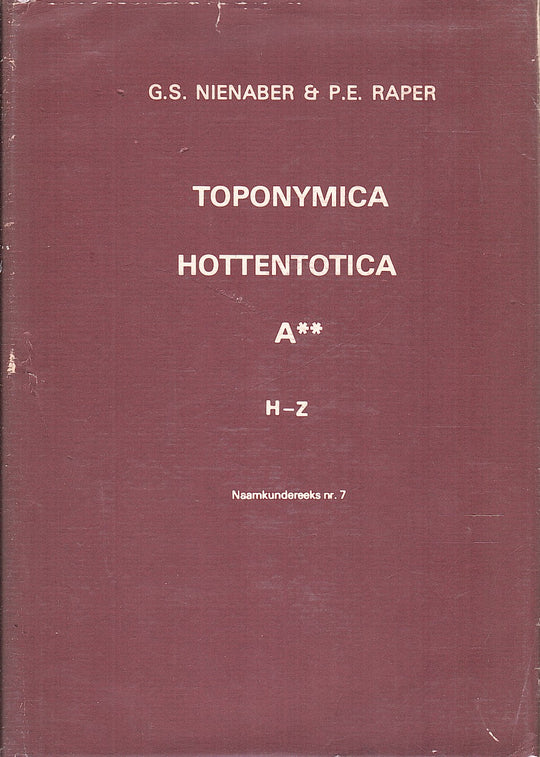eng
Alexander 1837/297 'On the Left of the Plain [The Keikaap of Grootvlakte] What a Broad and Winding Belt of High Trees and Bushes, Indicating The Course of A River, The Chuntop (Or That Which in Running Is Suddenly Checked) .. .the Notch is the Range Where The Wooded Chuntop Disappeared '. Ibid 2 130 'After Easy Descent, and at a Distance of Thirteen Miles from Eise, We Came to Chuntop, Or Sand Path, A Beautiful Place Under Rocks, With High Trees, and Grass Up to One's Waist'. Op kaart 'Chuntop r; This River is Lost in Sand Before It Reaches The W. Coast '. Judge 1845 Chart 'Chuntop' [REG Gesitueer BV. Tot Bullspoort en Noukof, Maar Dit Loop Tot in Oseaanlll Kleinschmidt FH 1855 Sources 20 53 'Start'. Kreft HH 1876 sources 3 237 '... to the river Tsondab, who goes through Bulsport ...'. Dove 1900 MITTH 64 'Tsondab, riverbed tree with diagets, slightly fluctuating asen. Tsomdab, perhaps better to turn around here, but means a river with soft shores, of which the loose earth rolls slightly rolling slightly, from TSOM, whose real meaning the coincidence of the sand in a water-filled pit or the access of one in the sand of the riverbed dug water hole by drinking cattle is. The river named as a Tsondab disappears in the west of the found in the Sande of a still the hottentot unknown in the hottentot, and I was very likely that this proprietary character of the waterfall has given the occasion to the name Tsondab '. Sprigade Moisel 1904 Warsk 'Tsondab (Chantop)', Rivier, En Daaraan Op S 2416 AA 'Tsondab', 'N Bron. PNK-SWA S.J. [19551 per Pastor HK Diehl SNR. 'Tsondab: Tso-Daob (TSO = sink into the earth)', Stel Voor Tsodaob. Krenz FK 1974 Boer Aantekening 'TSOA-N = falling in the sand or mud; -Dab = ornate = river '.
afr
Alexander 1837 / 297 'On the left of the plain [die KEIKAAP of Grootvlakte] was a broad and winding belt of high trees and bushes, indicating the course of a river, the Chuntop (or that which in running is suddenly checked)...the notch is the range where the wooded Chuntop disappeared'. Ibid 2 130 'After an easy descent, and at a distance of thirteen miles from Eisees, we came to Chuntop, or sand path, a beautiful place under rocks, with high trees, and grass up to one’s waist'. Op kaart 'Chuntop R; this river is lost in sand before it reaches the W. Coast'. Richter 1845 Charte 'Chuntop' [reg gesitueer bv. tot Bullspoort en Noukloof, MAAR dit loop tot in die oseaanlll Kleinschmidt FH 1855 Quellen 20 53 'Zuntab'. Kreft HH 1876 Quellen 3 237 '...an den Fluss Tsondab, der durch Bulsport geht...'. Dove 1900 Mitth 64 'Tsondab, im Flussbett stehende Baume mit diinnen, leicht schwankenden Asten. Tsomdab, das hier vielleicht besser an- zuwenden ware, bedeutet dagegen einen Fluss mit weichen Ufern, von denen die lockere Erde leicht herabrollt, von tsom, dessen eigentliche Bedeutung das Zusammenfallen des Sandes in einer mit Wasser gefiillten Grube oder das Zutreten eines in den Sand des Flussbettes gegrabenen Wasserloches durch trinkendes Vieh ist. Der gewohnlich als Tsondab bezeichnete Fluss verschwindet im Westen des Fandes im Sande eines bis heute auch den Hottentotten unbekannten Diinengebietes, und ich halte für sehr wahrscheinlich, dass dieser eigenthiimliche Charakter des Wasserlaufs den Anlass zu dem Namen Tsondab gegeben hat'. Sprigade-Moisel 1904 Kriegsk 'Tsondab (Chantop)', rivier, en daaraan op S 2416 AA 'Tsondab', 'n bron. PNK-SWA s.j. [19551 per pastor HK Diehl snr. 'Tsondab: Tso-daob (tso = in die Erde versinken)', stel voor Tsodaob. Krenz FK 1974 Boer Aantekening 'Tsoa-n = im Sand oder Schlamm fest- fallen; -dab = Ortlichkeit = Fluss'.




